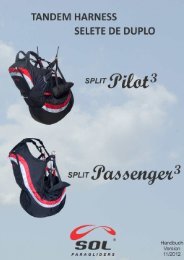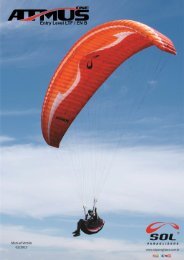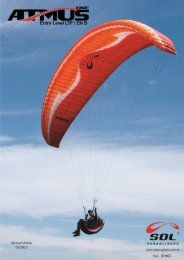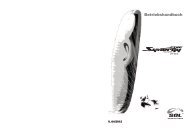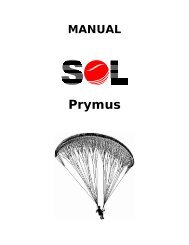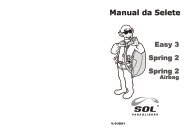Clique here - PDF Manual
Clique here - PDF Manual
Clique here - PDF Manual
- No tags were found...
You also want an ePaper? Increase the reach of your titles
YUMPU automatically turns print PDFs into web optimized ePapers that Google loves.
16Flight in turbulent conditionsIn turbulent conditions it is not recommended to fly the glider with full speed, causethe KUAT is than more sensitive to deformation and closing. The pilot must rememberthat the higher the speed, the more dynamic the collapse response or symmetricclosing will be.WarningThe KUAT requires active flying in turbulences! This can avoid canopyclosings and deformations.Active flightFor best performance during your flight, it is important to be always sensitive to whatyour canopy is trying to communicate. The key elements of active flying are theadvancements and tension control.When the canopy moves ahead of you, carefully apply the brakes, so that the canopyreturns to be above you, and if the canopy moves behind you, you must release thebrakes.Flying with the brakes lightly applied (+ - 20 cm) allows the canopy to fly slightlybehind. In turbulent circumstances the internal paraglider tension may change, whichyou will feel on the brakes. The idea is to maintain a constant tension, and in case youfeel loss of tension, apply the brake.These adjustments will make for a more controlled flight, and help in eliminating thepossibility of collapse.Avoid flying excessively with the brakes on because you might brake to the point ofstopping the canopy from flying. Always consider your aerodynamic speed. Yourmovements can be symmetric or asymmetric and both or one brake can be applied.We suggest that you do ground practice runs and advancing simulations. Tension losscan be simulated well on the ground.WarningNeither pilot nor any paraglider are immune to collapses; t<strong>here</strong>fore activeflying will decrease the chances of happening. When flying in turbulentconditions, be more active and avoid great advancements of the canopy byanticipating yourself too quickly with your response movements. Always maintainaltitude awareness and do not get into excessive commanding mode. We advise you tomaintain brake tension and avoid flying in extreme turbulent conditions.



